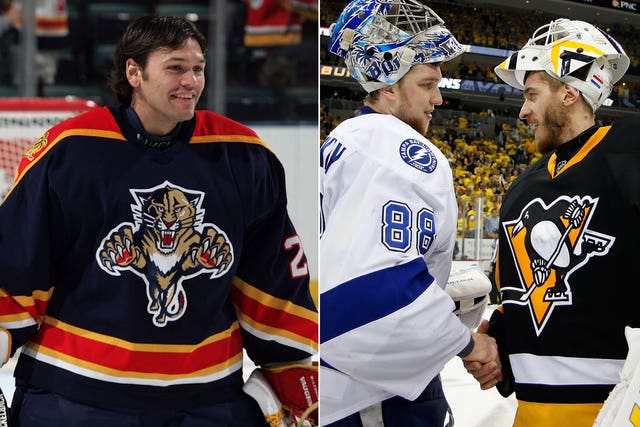
Being No. 2: Hockey's cushiest gig is also one of its toughest

This article appears in the Nov. 21, 2016 issue of SPORTS ILLUSTRATED. To subscribe to the magazine, click here.
Dante's Inferno envisions the ninth circle of hell as a frozen lake, trapping traitorous souls for all eternity, but it was the ice at the Blue Jackets' Nationwide Arena where, on Nov. 4, Montreal goalie Al Montoya discovered an even deeper level of damnation. Under ordinary circumstances Montoya would've been yanked early after surrendering three goals in the first 15 minutes against Columbus, and thus spared the full extent of what became a 10-0 pasting. But since Carey Price, consensus Best Goalie of Planet Earth, was scheduled to face Philadelphia the next night, and since Canadiens coach Michel Therrien wanted to let him rest, and since the Blue Jackets' lead soared to 8-0 by the end of the second ... as one NHL goalie coach put it: "Montoya was Secret Service. He took a bullet for the president."
As the pucks kept flying in Columbus, Jason LaBarbera began texting other former and current goalies to commiserate. "We were like, 'Man, I feel bad for him,'" says LaBarbera, who played in 187 games for six teams over 11 NHL seasons before retiring in July. "Everybody at some point or another has been in his shoes." And everyone reacts differently. The 31-year-old Montoya betrayed no signs of frustration, even when several Habs defensive breakdowns led to slam-dunk goals. LaBarbera, by contrast, once let in five during the first period of a game, stormed into the bathroom at intermission and ripped a stall door from its hinge. "It's frustrating because you haven't played for a while, then that's your start, then you've got to sit on that," he says. "It can get to you."
Like third-string catchers or reserve quarterbacks, the backup-goalie life does contain certain perks, mostly based on the whole paid-to-do-nothing perception. "It's either the best job in hockey," says Scott Clemmensen, a former backup to Devils icon Martin Brodeur, "or the worst." In other words, the plum view from the end of the bench comes at a cost. For backup netminders, optional skates are never optional. They see scarce action during an 82-game season—usually coming in cold in relief or starting on the tail end of back-to-backs after landing in town past 2 a.m. Few teammates dare buzz the No. 1 goalie with high slappers during practice. But the human pincushion in the other crease? "When the backup comes in, it's snipe central," says Chris Mason, a journeyman netminder with four teams from 1998-99 to 2012-13.
"The old proverbial s---burger," LaBarbera says.
Fortunately, NHL arenas offer tastier options whenever hunger strikes. Today's grass-fed, farm-raised world may favor nutritional piety—"You can't just sit there and crush popcorn and candy and expect to not have it go to the hips," Minnesota goalie Devan Dubnyk says—but wafting arena smells and two hours of sitting gets the stomach growling.

This being the Never Hungry League, scoring grub isn't hard, but discretion is required. Ron Tugnutt, who played for eight clubs from 1987 to 2004, was known for letting his glove double as a potato chip bowl on the bench. "Chicken fingers are my weakness," New Jersey backup Keith Kinkaid says of the intermission order he once placed with the rink staff in Chicago. While Martin Biron was with the Sabres, fans slipped him bags of M&M's through the glass, and he sipped them from a paper Gatorade cup. In the early 1980s, John Garrett once saved pucks for Quebec with a hot dog stuffed down his leg pad—ketchup and mustard seeping into his sock—having found nowhere else to ditch it when he was summoned into the game mid-bite.
Usually, intuition tells backups when they'll be needed. (Price would go unused on Nov. 4, but as Montreal fell further behind, he was spotted in the tunnel, jiggling his legs to stretch out.) Garrett got caught ignoring the first rule of backup goaltending: Always anticipate hockey's call of duty—even, as Kinkaid learned while with New Jersey's farm team in Albany, if it comes while answering nature's call of duty. "I wasn't feeling well, so I ran to the bathroom," he explains. "The game started again, and then the guy who was starting got a stick to the face through his cage. So I had to rush out. Ended up getting the win."

Chad Johnson, now with Calgary, remembers replacing Bruins starter Tuukka Rask late in a 2014 blowout with a bellyful of still-digesting hot dogs. Former goalie Glenn Healy recalls his "Bambi moment," stepping onto the ice and slip-sliding around after forgetting to remove his skate guards. On Nov. 5, 2010, Washington's current No. 1, Braden Holtby, spent the first chunk of his NHL debut with one skate untied.
"I went from being real relaxed to real nervous in a hurry," says Holtby, who laced up at the next TV timeout. "It's never how you draw it up, I guess."
Until the 1965 playoffs the NHL didn't even require teams to dress two goalies, which had resulted in some memorably suboptimal subs: Rangers coach Lester Patrick in the '28 Stanley Cup final, trainer Ross (Lefty) Wilson for three teams in the '50s and Bruins forward Jerry Toppazzini for 30 seconds on Oct. 16, 1960.
The modern-day backup, however, might be more important than ever. All four teams in last season's conference finals used their No. 2 during the series, which hadn't happened in 36 years, and Pittsburgh rookie Matt Murray, who played just 13 games during the regular season, started all six of the Cup finals. "In today's league," Dubnyk says, "you need a backup that's very capable of winning a game. Or, if the starter gets hurt, carrying the team."
Still, since the bulk of the backup's existence is spent waiting in the wings, everyone has different methods for staying engaged. Some keep busy operating the bench door. Healy logged mental scouting reports on opponents, which he later jotted into a notebook. LaBarbera did play-by-play under his breath. Former Rangers backup Steve Valiquette learned from a sports psychologist to visualize making saves on the bench while starter Henrik Lundqvist was doing so for real on the ice.

Beyond the standard-issue team ball caps, backups indeed wear many hats. They are sounding boards for the starters, therapists for frustrated teammates, rays of sunshine during the long season. "Body language is really important," LaBarbera says. "No one likes a pouty goalie." And because they play so infrequently, their value is tethered to positive attitude. "A good backup has to have the pulse of the dressing room," says TSN's Jamie McLennan, one of a growing number of goalies turned analysts. "That's where you do most of your work."
Sometimes they don't even get to share the bench. In Montreal's Bell Centre, visiting backups sit opposite their teammates, isolated in the entrance tunnel; at Carolina's PNC Arena, they sit with the Zamboni and ice crew. "When you're on the bench, guys are coming in, guys are going out, you have the sounds, you're part of it," Dubnyk says. "And when you're behind the glass, sitting in the corner somewhere, you're not. You're a fan."
What else to do then but play the part? LaBarbera would give nearby civilians whiffs of his pregame smelling salts and laugh at their twitchy reactions. In Buffalo, Biron kept regular bets with a stick attendant about one of the in-arena games, a roulette-style McDonald's Happy Wheel. "I used to have a gentleman who sat behind me in Philadelphia who used to scream and yell at me about my family," Healy says. "I would proceed every game to wipe Vaseline on the glass so he couldn't see the ice." As the Sabres completed their sweep of Montreal in Game 4 of the Eastern Conference finals on May 14, 1998, backup Steve Shields was taking periodic trips to the locker room because he couldn't miss the series finale of Seinfeld.
"That's probably one of the characteristics of a good backup, being a guy who can go from zero to the middle of the action in about a minute," Shields says. "Being able to relax and chill out, have a bite to eat or something to drink, is not out of the ordinary. Sometimes, on a Tuesday night in December, the game can get tough to watch. We've got to do something to pass the time."

Five days after becoming the first goalie to allow 10 goals since Valiquette did in February 2009, Montoya finally spoke to the Montreal media. He focused on the Canadiens' 5-4 rebound win against Philadelphia, in which the rested Price made 34 saves and won his seventh start in a row for the Atlantic Division-leading Habs. He joked about the famously deafening Nationwide Arena cannon, which booms whenever the Blue Jackets score. "It was all just a big blow," he laughed to reporters.
In moments like these the gig is toughest. "It was brutal," Valiquette says, recalling his 10-goal debacle. "It took me two years to get over it. It was basically fear. Pick whatever profession you're in. The most embarrassing thing that can happen in your profession? Allowing 10 goals is one in ours."
That Montoya seemed to take his fate in stoic stride—unlike, say, Patrick Roy, who in 1995 famously demanded a trade after Habs coach Mario Tremblay hung him out to dry while giving up nine goals—showed a self-awareness required of every backup. "The guys who have been able to stick around and be good at it, those guys come to the rink every day, they're in a good mood, they work hard, they get what their job is," LaBarbera says. "Some guys, for whatever reason, they can't figure a part of it out."
For netminders like San Jose's Martin Jones and Edmonton's Cam Talbot, successful apprenticeships with other teams—the Kings and the Rangers, respectively—can lead to starting gigs elsewhere. Others, like Montoya, who was a sixth overall pick in 2004 but has never stayed with one team for more than two years, crisscross the league, finding work on reputation and demand. "You can definitely get labeled into a certain role," says Johnson, who is on his fourth team in four years. "They put you in a box, and they can't see outside of that."

That makes the few chances backups get to play even more pressure-packed, since one bad outing can tip the statistical scales out of their favor. It took nine days before Montoya played again, a 3-2 loss in Chicago on Sunday in which he made 32 saves. "You're fighting for survival," Washington goalie coach Mitch Korn says. "You don't have the freedom to fail and bounce back quickly."
Naturally, this leads to acts of desperation. In October 1997, McLennan was playing in St. Louis, backing up Grant Fuhr. On a road trip to Philadelphia, McLennan was scheduled for a rare start when he developed the flu. Unwilling to pass on the opportunity, though, he began the game in net but seized up midway through, so dehydrated that his body went into spasms. Before trainers hauled him off the ice, McLennan looked up and spotted Fuhr, meandering nearby. The future Hall of Famer had clearly embraced the reserve role in full, at least for the night. "Do you need me to come in?" Fuhr asked McLennan, his words muffled by a mouthful of jawbreaker candy.
This article originally appeared on

